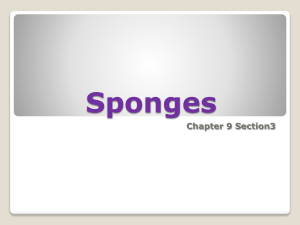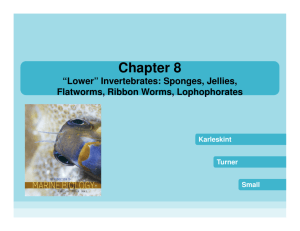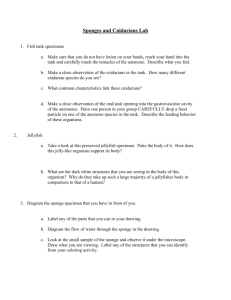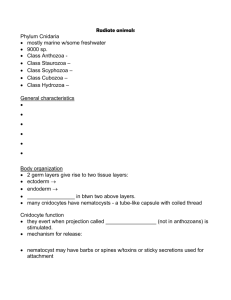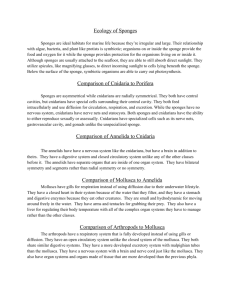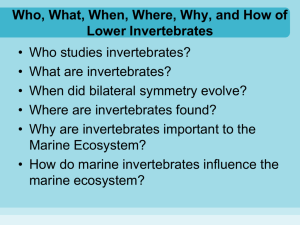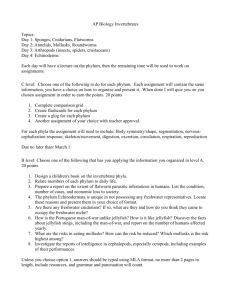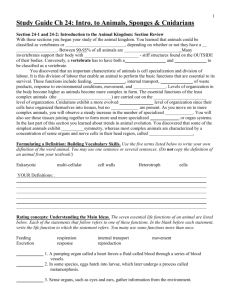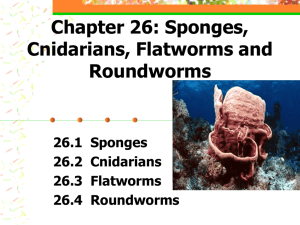Sponges
advertisement
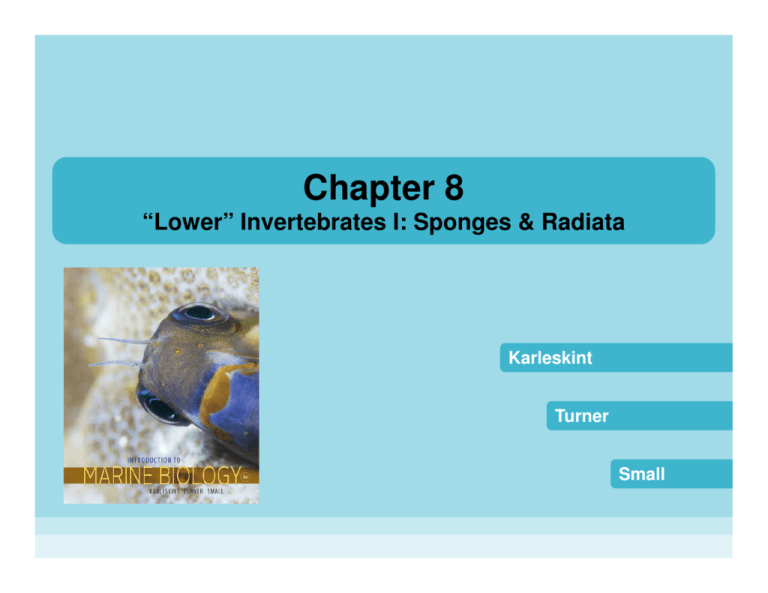
Chapter 8 “Lower” Invertebrates I: Sponges & Radiata Karleskint Turner Small Key Concepts • Sponges are asymmetric, sessile animals that filter food from the water circulating through their bodies. • Sponges provide habitats for other animals. • Cnidarians and ctenophores exhibit radial symmetry. • Cnidarians possess a highly specialized stinging cell used to capture prey and for protection. What Are Animals? Animals: 1. 2. 3. 4. multicellular eukaryotic cells without cell walls cannot produce their own food Invertebrates or vertebrates (most animals are invertebrates) Sponges Phylum Porifera • Basic characteristics: – no tissues or organs – asymmetric – sessile Anon. Wiki Commons Sponge Structure and Function Sponge Structure and Function 3 basic body forms: leuconoid from most efficient, most common Sponge Structure and Function • Nutrition and digestion – suspension/filter feeders – collar cells (choanocytes) filter out tiny food particles – pinocytes and archaeocytes (a.k.a. amoebocytes) ingest larger food particles by phagocytosis – Most food digested and distributed to other cells by archaeocytes Sponge Structure and Function • Reproduction in sponges – asexual reproduction • budding • fragmentation – sexual reproduction • most hermaphrodites • eggs from archaeocytes and sperm from modified collar cells Fertilization Sperm cell engulfed by a choanocyte Egg cell Asexual reproduction Bud Sperm cell (modified choanocyte) Embryo Sexual Planktonic reproduction amphiblastula larva New sponge New sponge Larva settles and attaches to bottom or other surface Figure 8-4 p193 Ecological Roles of Sponges • Competition – corals and bryozoans • Predator-prey relationships – few species eat sponges • spicules • chemical deterrents Ecological Roles of Sponges • Symbiotic relationships – mutualistic or commensalistic hosts – organisms live within the canals Ecological Roles of Sponges • Sponges and nutrient cycling – boring sponges Cnidarians: Animals with Stinging Cells • Include jellyfish, hydroids, corals and sea anemones • cnidocytes ErgoSum88 Organization of the Cnidarian Body Stinging Cells • Cnida – nematocysts Stinging Cells • Dangerous species – Portuguese man-of-war – box jellyfish Types of Cnidarians • Hydrozoans or Hydroids – mostly colonial – colonial forms contain 2 types of polyp: • Feeding polyp • Reproductive polyp – hydrocorals secrete a calcareous skeleton – some produce floating colonies (e.g. P. man-o-war) Types of Cnidarians • Jellyfish – scyphozoans—true jellyfish (class Scyphozoa) • plankton • medusa is predominant • photoreceptors Types of Cnidarians • Box jellyfish – box jellyfish (class Cubozoa) • • • • box-shaped bells relatively strong swimmers tropical complex eyes (imageforming?) • voracious predators, primarily of fish Types of Cnidarians • Anthozoans (class Anthozoa) – include sea anemones, corals and gorgonians – sea anemones • benthic • gastrovascular cavity divided • though sessile, many can change locations Types of Cnidarians • Anthozoans (class Anthozoa) – coral animals • polyps secrete a calcium carbonate skeleton • stony corals form reefs Nick Hobgood Types of Cnidarians • Anthozoans (class Anthozoa) – soft corals • polyps that form plant-like colonies Nutrition and Digestion • Gastrovascular cavity – digestion and transport – 1 opening: mouth/anus • Many suspension feeders • Jellyfish and box jellyfish are carnivorous • Sea anemones generally feed on invertebrates, some large species feed on fish, shallow water species have symbiotic algae Reproduction • asexual polyp stage – fission, budding common in corals – strobilation common in hydroids and jellyfish • sexual medusa stage Reproduction • Anthozoans – asexual reproduction IS COMMON • pedal laceration • fission • budding – sexual reproduction • male and female forms, gametes are released • planula larva Ecological Relationships of Cnidarians • Predator-prey relationships – cnidarians are predators – stinging cells discourage predation – sea turtles, some fish and molluscs prey on hydrozoans and jellyfish Ecological Relationships of Cnidarians • Habitat formation – coral polyps form complex 3-dimensional structures inhabited by thousands of other organisms – coral reefs provide a solid surface for attachment, places for pelagic animals to rest and hide and buffer waves and storms Terry Hughes Ecological Relationships of Cnidarians • Symbiotic relationships – Portuguese man-of-war and man-of-war fish – reef-forming corals and zooxanthellae – sea anemones: • clownfish • hermit crab Ctenophores • Planktonic, nearly transparent • Ctenophore structure – 8 rows of comb plates – radial symmetry – lack stinging cells – bioluminescent Ctenophores • Digestion and nutrition – Gastro-vascular cavity – feeds on plankton, larval fish and fish eggs – branched tentacles, adhesive cells, jellyfish stingers to capture prey
